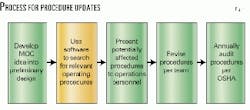Software enables cost-effective updates of operating procedures
The BP Amoco Toledo, Ohio, refinery is testing and using a method to make updating and certifying procedures less time consuming.
US Occupational Safety & Health Administration (OSHA) Process Safety Management (PSM) regulations require that operating procedures be accurate and complete at all times. Operating procedures must also be annually certified as current and accurate.
This seemingly simple requirement demands considerable time and effort on the part of operators, trainers, and procedure personnel. Many units have 50-100 operating procedures.
In a continuous effort to improve work practices, the Toledo refinery is using a software tool provided by Engineering & Technical Associates Inc., Walbridge, Ohio, that allows affected existing procedures to be easily identified during the design phase of a project.
All procedures are indexed to allow text searches. Once the pertinent procedures are identified, operations and procedure personnel review them and make revisions.
A major benefit to this new tool, says Bill Downey, PSM Coordinator at the refinery, is that writers need not manually search existing procedures to determine where the procedure language is affected.
How it works
When the management of change (MOC) process is under way, the originator reviews the MOC to identify key words, phrases, relationships, and equipment numbers that can be used to search existing procedures.
Using these queries, the computer searches the text within operating procedures to identify matching language and numbers as potential hits.
The computer program highlights the text that matches the key words. If the potential hits are truly related to the MOC, the procedure is marked up to show the affected section and then sent to the operators, trainers, and procedure personnel.
This computer search eliminates the arduous task of determining which procedures are affected. According to Paul Henry, training coordinator at the refinery, the new tool enables procedure personnel to focus their energy on the required changes rather than spend time identifying procedures.
When the annual OSHA certification time arrives, an operator conducts a thorough review of sample procedures to ensure that proper updates have been made.
The new management system increases the chances of good audit results because using the new system implicitly compels procedures to be continually updated throughout the year. If the auditor deems the sampled procedures and ongoing process of procedure maintenance as acceptable, the yearly certification is complete.
Fig. 1 shows a diagram of the process, beginning with an MOC idea and ending with the annual certification.
Initial results
Downey says that out of 200 MOC items reviewed thus far, 75 have been found potentially to affect existing procedures. As a result, the need to review the remaining 125 MOCs for their effect on existing procedures was eliminated.
Thus, the software program removed most of the time and effort normally involved in procedure review. Yearly certifications can also be simplified through the use of this tool as existing MOCs are reviewed against each unit to gauge their effect on procedures.
One example of how the system works involves an MOC that increased the maximum flow stop on a control valve for feed to a reformer unit.
Prior to the MOC, the control valve was limited and the bypass was opened to get the desired rate. The MOC increased the maximum flow stop on the control valve so that the normal operation could be accomplished without opening the bypass.
The search tool allowed a search of the 42 reformer unit procedures in seconds. The search words used were control valve number "FRC - 4554," "bypass," and "maximum flow valve."
The search resulted in a hit list of 11 of the 42 procedures. Clicking on each of the hits brought up the procedure with a flag for the hit. A quick review of the 11 hits on the computer resulted in three specific procedure changes needed.
Each of these procedures needed to be changed to close the bypass for normal conditions. The total time to determine the specific three procedure changes needed was less than 5 min.
Another example also involved the reformer unit.
An MOC project replaced the existing inert-gas regeneration system with a new nitrogen-regeneration system. A search of the 42 reformer procedures, using "inert gas" and "regeneration" as the search criteria, identified nine procedures that refer to inert gas regeneration.
Five of those procedures contained detailed steps on operating the system with inert gas regeneration, while the other four merely reference the system interfaces. The total search time for this MOC was also less than 5 min.
Benefits
This method reduces the time spent searching procedures for changes, quickly provides operators with updated changes, and keeps procedures evergreen. Downey estimates the method will save at least 1,000 hr/year of supervisor time spent searching procedures. There will be additional indirect savings as valid procedures are readily available for operations.
He says that the greatest benefit can be found in the intangibles. This method enables people to focus their energies on more value-added tasks based on their knowledge and experience. Procedure searches can be done away from the site, allowing a centralized group to focus its attention on this task.
Yearly certifications become less time-consuming and more efficient because they are an auditing process, rather than a total review.
Finally, better procedures lead to a safer, more-efficient operation and lower-cost operation.

